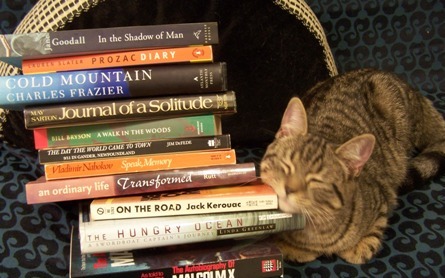On Sunday of our first week at Fort Arbeia, we went out and explored Hadrian's Wall. Nick gave us a tour of the sites, and explained the history of the wall. The Romans started building the wall in AD 122. The purpose of the wall was to provide a military barrier, so that the 'heathen' tribes of Scotland would be less inclined to attack. Along the wall are several forts and turrets.The wall is an amazing 72 miles long.
We hiked from Homesteads Fort west for about 2 1/2 miles, through very windy but very beautiful country on both sides.
After lunch we visited a fort called Vindolanda, which had a fantastic museum. Vindolanda has been excavated since the 1970's. The site is especially unique compared to other Roman sites because the chemical composition of the soil allowed for the survival of items such as leather, wood, and cloth.
The most amazing items in the museum were the hundreds of excavated Roman shoes---soldiers and citizens, women, men, and children. Also there were leather items such as horses' harnesses and bridles. By far the most exciting finds at Vindolanda are written tablets, of ink on very thin wood. The written correspondences depict the day to day life of the fort.
Most exciting from my feminist perspective is the discovery of a woman named Claudia Severa's letter to her friend Sulpicia Lepidina, inviting her to a birthday party.
Apparently this is one of first known examples of a woman's writing to survive from ancient times.
Monday, August 19, 2013
Tuesday, August 13, 2013
Second Day at Fort Arbeia
 |
| Heather & Diane at the dig |
Romans typically built their forts near rivers, and Arbeia is situated at the entrance of the River Tyne. This gave the Romans the ability to transport goods all along the Northern frontier of the Roman occupation, or along Hadrian's Wall.
Fort Arbeia has several reconstructed buildings, such as the West Gate, the soldiers' barracks, the centurion's quarters, a latrine for the foot soldiers, and the commander's house. We toured all these on Monday.
Yesterday soon after we began digging a little girl local volunteer found a coin from 350 AD.
found a small buckle from a horse's bridle, and a hairpin.
Today was a less exciting day, but I felt more comfortable. We did not find anything of import but I found a piece of an amphora. Interestingly I had just watched a program about these common Roman vessels- frequently used to carry wine or olive oil- on a tv program just before I left for England.
Friday, August 2, 2013
Acquisitions in the Museum of the Baronesque
The Museum of the Baronesque has been somewhat quiet these days. Money and space are the constants. If only the Baron had more room, (and lots of extra money) there would be an ever-growing collection of goodies. In some ways, thank goddess space limitations keep the Baron in check. Otherwise her apartment might turn into a landslide.
Here are some newbies in the Museum of the Baronesque. My favorite is definitely the Amish Man and Lady salt and pepper shakers.
1. Happy Amish Man and Lady Salt and Peppers Shakers
2. Avocado Salt and Pepper Shaker
3. Owl Plate
4. Fab Juice Glasses
Here are some newbies in the Museum of the Baronesque. My favorite is definitely the Amish Man and Lady salt and pepper shakers.
1. Happy Amish Man and Lady Salt and Peppers Shakers
 | ||
2. Avocado Salt and Pepper Shaker
 |
3. Owl Plate
 | |||||||||||||||||||||||||||||||||||||||||||||||||||||||||||||||||||||||||||||||||||||||||||||||||||||||||||||||
4. Fab Juice Glasses
 | ||||||||||||||||||||||||||||||||||||||||||||||||||||||||||||||||||||||||||||||||||||||||||||||||||
Subscribe to:
Posts (Atom)








